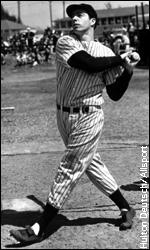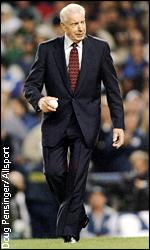 |
| | Tuesday, July 25 SportsCentury biography of Joe DiMaggio | ||||||||
| By Larry Schwartz Special to ESPN.com Joe DiMaggio was more than the most complete all-around player of his generation. He was more than the player who set one of the game's most cherished records, hitting safely in 56 consecutive games. Baseball has produced many icons, but it has produced only one Joe DiMaggio. He has proved to be the most enduring symbol of baseball greatness. In the almost half a century from his retirement until his death on March 8, 1999, he retained his image as America's ultimate hero. What American male wouldn't sell his soul to the devil to duplicate the exacta that Joltin' Joe accomplished - playing centerfield for the Yankees and marrying the sexiest woman on the planet? "Joe DiMaggio is what you get when you build mystique on top of greatness," said Ron Swoboda, the former Met who played a generation after DiMaggio. Though known to be short tempered in private, DiMaggio refrained from showing such behavior in public. A painfully private person, he always was careful and protective of his image, understanding that it was his legacy. "It is not for DiMaggio's records that we remember him," wrote Ira Berkow of The New York Times. "He is best remembered for the persona of Joe DiMaggio. He remains a symbol of excellence, elegance, power and, to be sure, gentleness." His marriage to Marilyn Monroe was an amazing coupling of American celebrityhood: The country's most revered athlete hitched to its most adored actress. There was this conversation when she returned to their honeymoon in Tokyo after entertaining more than 100,000 servicemen in Korea: "It was so wonderful, Joe," she said. "You never heard such cheering." "Yes I have," he said. DiMaggio burst on to the major league landscape in 1936, helping the Yankees begin another dynasty. After winning only one pennant and World Series in the previous seven years, they won four straight world championships. In DiMaggio's 13 seasons, they won 10 pennants and nine Series.<
"A nation turns its lonely eyes to you." Earlier, Ernest Hemingway had turned to the Yankee Clipper when he sought a symbol. In his novel The Old Man and the Sea, the old man says, "I would like to take the great DiMaggio fishing. They say his father was a fisherman. Maybe he was as poor as we are and would understand." He was a fisherman, all right. Joe, the eighth of nine children, was born on Nov. 25, 1914, in Martinez, Calif., a small fishing village 25 miles northeast of San Francisco. The next year, his father moved the family to San Francisco because he heard the fishing was better off its waters. While Zio Pepe, as DiMaggio's father was called, wanted his five sons to become fishermen like him, only the oldest two did. Joe and brothers Vince and Dom became major league baseball players. Joe spent three seasons with the San Francisco Seals, and set a Pacific Coast League record by hitting safely in 61 consecutive games as a rookie in 1933. "Baseball didn't really get into my blood until I knocked off that hitting streak," DiMaggio said. "Getting a daily hit became more important to me than eating, drinking or sleeping. Overnight I became a personality." The Yankees bought him for a reported $25,000 and five players after the 1934 season. They kept him in San Francisco for another year, and he tore up the PCL again with a .398 average, 34 homers and 154 RBI. As a rookie with the Yankees, he was on the cover of Time during the 1936 season. While Lou Gehrig was the A.L. MVP, DiMaggio, who didn't play until May 3 because of a burned leg, contributed mightily by hitting .323 with 29 homers (two coming in one inning), 132 runs and 125 RBI. He also led A.L. outfielders with 22 assists. DiMaggio helped the Yankees to totals of 102, 102, 99 and 106 victories his first four seasons plus a 16-3 record in the World Series. In the summer of 1941, a nation turned its eyes to him. During his record hitting streak, which began on May 15 with an inauspicious 1-for-4 game, the Les Brown band recorded Joltin' Joe DiMaggio, a hit that was played day and night on the radio. Finally, on July 17, before a crowd of 67,468 in Cleveland, pitchers Al Smith and Jim Bagby Jr. kept him hitless, thanks to two outstanding plays by third baseman Ken Keltner and a good one by shortstop Lou Boudreau. He hit .408 (91-of-223) with 15 homers and 55 RBI during the streak. After that game, DiMaggio went on a 16-game hitting streak. DiMaggio, who batted .357 for the season, won the MVP despite Ted Williams hitting .406 with a league-leading 37 homers. He also took the 1947 MVP - by one point - over Williams, though the Splendid Splinter won the Triple Crown. In the late 1940s, DiMaggio showed his Achilles heel. And it was to his heels. At times, he said, "it felt as if a nail was stuck into them - only 20 times worse." An operation in November 1948 didn't help much, and he wasn't able to play until June 28. He made a legendary return, hitting four homers and knocking in nine runs as the Yankees swept three in Boston. DiMaggio hit .346 in 76 games, and the Yankees won the pennant on the season's final day by beating Boston. Hitting .373 for the final six weeks of 1950, lifting his average to .301, and driving home 122 runs probably convinced him he had one more year left despite his lingering ailments. He didn't - sinking to .263 and 12 homers - and tearfully retired in December 1951. "I stayed one season too long," he said. Incredibly, DiMaggio wasn't elected to the Hall of Fame in his first year of eligibility, or even in his second, but in his third. After his love affair ended with baseball, he began one with Monroe. He was 39, she 27 when they married on Jan. 14, 1954, despite, according to Gay Talese in Esquire, "disharmony in temperament and time: he was tired of publicity, she was thriving on it; he was intolerant of tardiness, she was always late."
| ALSO SEE 10th Inning | ||||||||

